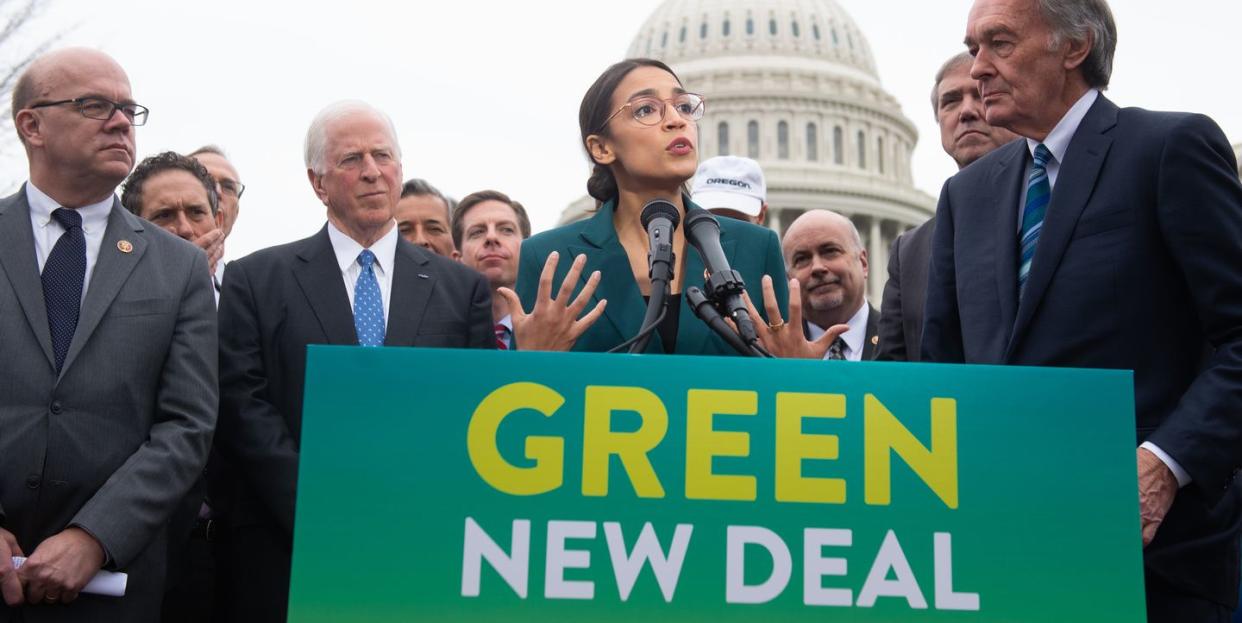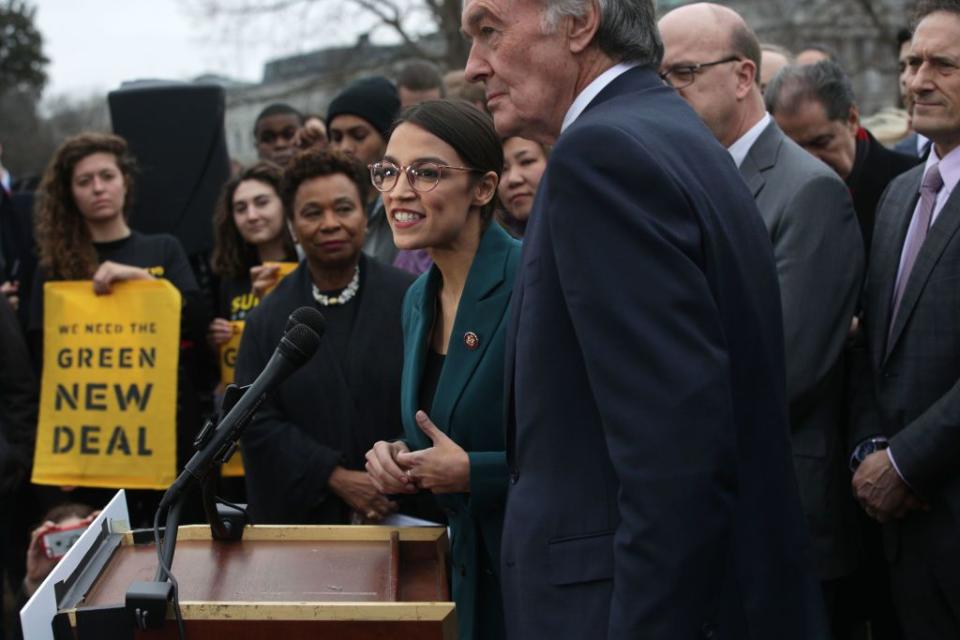Here's What the Green New Deal Actually Says

Alternative energy, climate change, and other environmental issues were thrust back into the forefront of the American political dialogue in February with the arrival of the "Green New Deal."
The term, which first entered the vernacular in 2007 when New York Times columnist Thomas Friedman suggested the idea, has become a watchword for Democratic star Rep. Alexandria Ocasio-Cortez and her allies, who are echoing the language of Franklin Delano Roosevelt in proposing a sweeping new program to transition America's energy economy and, they hope, create a slew of jobs in the process.
Now Ocasio-Cortez and Sen. Ed Markey have unveiled an outline of a Democratic Green New Deal, and Washington is girding for a fight over the future of American energy. You can read the full plan here, but here are the basics.
All Renewable Energy, All the Time
For starters, the plan proposes generating 100 percent of electricity through "clean and renewable" sources in the next ten years.
"Clean" is a tricky word in conversations about energy, since people use it to describe sources that very much are not. In this case, the word "clean" is doing a lot of work, essentially removing nuclear energy and carbon capture technology from the Green New Deal's ambitions. While both of those technologies can reduce carbon dioxide emissions, they produce other troubling by-products-radioactive waste, in the case of nuclear.
.@AOC unveils #GreenNewDeal: "There is no justice and there is no combating climate change without addressing what has happened to indigenous communities. That means that there is no fixing our economy without addressing the racial wealth gap." https://t.co/2wVPSEOIhk pic.twitter.com/NK2ANbiCcQ
- The Hill (@thehill) February 7, 2019
Sen. Ed Markey: "When we talk about a #GreenNewDeal, we are talking about jobs and justice. We are talking about the greatest blue-collar job creation program in a generation." https://t.co/2wVPSEOIhk pic.twitter.com/wpG1Rb3D7d
- The Hill (@thehill) February 7, 2019
Instead, energy sources like wind, hydroelectricity, and solar would likely play large roles here, with geothermal energy possibly assisting as well. Of course it's not just as easy as swapping things out; building a grid that can provide consistent output using nothing but renewable sources that can be quite variable is a large engineering challenge that requires smarter wind turbines and better battery technology, and the materials necessary to build it all, to say the least. And a whole lot of money.
Taken at face value, the plan would go a long way toward reducing America's carbon footprint. Fossil-fuel combustion is America's biggest source of greenhouse gases (GHGs). Currently every kilowatt hour generated in the U.S. produces "an average of 0.954 pounds of CO2," according to the University of Michigan, and coal is the worst offender, releasing 2.2 pounds for every hour.
Jobs, Jobs, Jobs
President Franklin Roosevelt's original New Deal, a series of economic programs that did everything from start Social Security to build out rural infrastructure, was intensely focused on putting Americans back to work during the Depression. This new program has a wide berth and an eye toward jobs. "Millions of family supporting-wage, union jobs" and a "just transition for all communities and workers" are mentioned, as well "prioritizing investment, training, climate and community resiliency, economic and environmental benefits in these communities."
Some of these jobs would come from a push to "massively expand clean manufacturing" in work projects like "solar panel factories, wind turbine factories, battery and storage manufacturing, energy efficient manufacturing components." Some industries, such as solar panel construction, have struggled to compete for workers in coal-friendly states since they can't currently match coal's high salaries.
New, Greener Infrastructure (Lots of Trains)
According to the American Society of Civil Engineers, America's infrastructure currently earns a school grade of D+, with perhaps the brightest spot being rail. The Green New Deal proposed today would want to radically expand that bright spot, with a call to "build out high-speed rail at a scale where air travel stops becoming necessary." Other transportation sectors are mentioned as well, including electric cars: The Green New Deal wants to "totally overhaul transportation by massively expanding electric vehicle manufacturing" and "build charging stations everywhere."
Transportation is America's second-largest producer of GHGs, producing 28 percent of the country's total. Ground vehicles from cars to long-haul trucks make up the vast majority of these emissions-83 percent according to the EPA. Airplanes make up a much smaller part of emissions at 9 percent. There's no mention in the Green New Deal of newer transportation technologies like electric planes.

There's also a focus on buildings, with a desire to "upgrade or replace every building in US for state-of-the-art energy efficiency." It's an ambitious goal, and one that would likely focus on the South and the Midwest, according to the American Council for an Energy-Efficient Economy's most recent scorecard. States like Louisiana have only made "limited efforts" to update their buildings to become more energy efficient, while Wyoming has voluntary building-efficiency standards based on codes written in 1989. Of course there's also a danger of going too far in replacing existing construction that's nowhere near its end of life; in many ways the greenest building is one that's already built.
The Green New Deal doesn't stop there, calling for "massive" investments in DARPA-style projects, referencing the experimental agency within the Department of Defense that helped birth the internet. There's no reference to ARPA-E, the agency with the Department of Energy currently set up to handle such projects.
But It's Just an Idea, for Now
This is a massive suite of proposals. Each field mentioned in the Green New Deals contains within it worlds of infrastructure and bureaucracy. "Even if every billionaire and company came together and were willing to pour all the resources at their disposal into this investment," reads the proposal, "the aggregate value of the investments they could make would not be sufficient."
The proposal has been met with acclaim by various Democratic presidential candidates and environmental groups, and is sure to be much discussed during the 2020 campaign. It's unlikely to be brought up in Congress any time soon, but given the scope of the threat climate change poses, the proposals will likely remain at the center of national debate.
The Rollout, and the Fallout
There was some confusion about the Green New Deal rollout: this article relied on a factsheet sent out by Rep. Ocasio-Cortez to the press. This factsheet differs in several ways from the actual non-binding resolution entered into the Congressional record, most notably on the issue of nuclear power. While the resolution calls for getting 100 percent green energy "through clean, renewable, and zero-emission energy sources," it does not mention nuclear energy in any capacity. The factsheet, since removed from Rep. Ocasio-Cortez's website, did.
In any case, the Green New Deal has re-energized people on all sides of environmental policy. Its detractors claim that the sweeping proposal, which includes a jobs guarantee and retirement security, is "unrealistic and ruinously expensive." Proponents argue that given the severity of the threat of climate change in 2019, "environmental policy is economic policy."
The debate has fallen into three main camps, two of them antagonistic to the GND. One of these groups are conservatives who antagonistic to the proven science of climate change, like President Trump. This group is ostensibly excited for the chance to show the plan as Democratic overreach-“It’s much easier to say I care about climate change but oppose the Green New Deal,” Alex Conant, a Republican strategist and former communications director for Marco Rubio’s 2016 presidential bid, told Buzzfeed News.
Of course, caring about climate change would mean admitting that human action is negatively and permanently altering the planet, a position that Rubio and others refuse to hold. This group plans on holding the Green New Deal as a cudgel over Democrats. Among them is Senate Majority Leader Mitch McConnell, who wants to hold a vote on the current 14-page plan.
.@Senatemajldr: "I've noted with great interest the Green New Deal. And we're going to be voting on that in the Senate. Give everybody an opportunity to go on record and see how they feel about the #GreenNewDeal." pic.twitter.com/1HP5lSDjzM
- CSPAN (@cspan) February 12, 2019
This isn't a new Republican trick. By rushing a vote on the #GreenNewDeal resolution, Republicans want to avoid a true national debate & kill our efforts to organize. We’re having the first national conversation on climate change in a decade. We can’t let Republicans sabotage it.
- Ed Markey (@SenMarkey) February 12, 2019
Separate to this group are those who acknowledge climate change as a danger but find some of the Green New Deal's economic plans untenable. Bloomberg Opinion economics writer Noah Smith, in a piece titled "How to Design a Green New Deal That Isn’t Over the Top," praised the current proposal on a number of fronts, like its focus on new technologies, building a smart electrical grid, and retrofitting projects. But Smith wants to avoid "open-ended commitments like a federal job guarantee or universal basic income," fearing "excessive budget deficits."
But the third group, active Green New Deal supporters, see these measures as necessary to help deal with the massive transitions American society will undergo to battle climate change. Jeddidiah Purdy, a law professor at Columbia, writes in a New York Times op-ed:
"You might say that producing the disaster of global climate change has taken a lot of economic policy and produced a lot of jobs programs. Reversing direction will take the same. Since environmental policy can happen only through economic policy, there is no avoiding decisions about what sorts of work there will be, and in which industries. It’s unsettling, but maybe a little less so when you consider that we’ve been doing it all along, usually without owning up to it."
Recent history points to the challenges of implementing environmental policies without significant social policies in tow. A gas tax hike in France, ostensibly undertaken for environmental purposes, sparked a civil unrest in rural parts of the country that became known as the Yellow Vest movement. While a recent poll showed a majority of the country disagreeing with continued mass protests in the streets of Paris, it also showed a majority of the country supporting the movement's goals.
Climate change will continue to disrupt the lives of ordinary Americans through more powerful storms, increased fire risks and weakened natural habitats. The Green New Deal is likely to be the first of several proposals on how to deal with these changes.
('You Might Also Like',)

